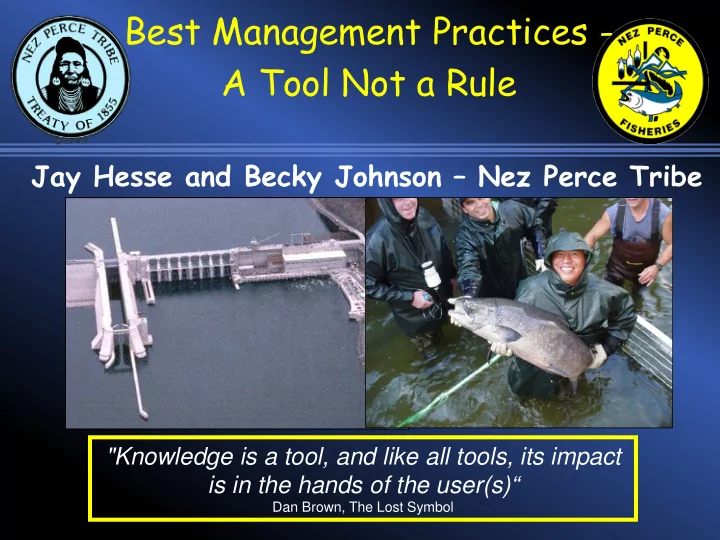

Best Management Practices - A Tool Not a Rule Jay Hesse and Becky Johnson – Nez Perce Tribe "Knowledge is a tool, and like all tools, its impact is in the hands of the user(s)“ Dan Brown, The Lost Symbol
Tool versus Rule Tool – something used in performing an operation or necessary in the practice of a vocation or profession. Rule - a regulation or bylaw governing procedure or controlling conduct.
Conservation Hatchery Best Management Practice Recommendations “The HSRG’s recommendations are not the only possible alternatives for managing hatchery programs to meet conservation and harvest goals. As such, the managers may develop other solutions which better meet their program principles and goals. Success over time will be defined by the managers’ ability to take actions in the future to adjust hatchery programs based on good science to meet their conservation and harvest goals.” -- Jim Waldo, Chair Columbia River Hatchery Reform Steering Committee
Snake River
• One extant population – Hatchery genetics very similar to natural-origin (endemic brood program) – 15% of historical habitat assessable • Two extinct populations • Congressionally mandated mitigation hatchery program
Conservation Hatchery Best Management Practice Recommendations • Proportion Natural Influence (PNI) >0.67 - Maximize percent natural origin in broodstock - Minimize percent hatchery origin on spawning grounds • 100% marked hatchery production • Selective harvest regimes • Mimic natural life histories
pHOS pNOB 1.00 0.75 0.50 Proportion Natural Influence (PNI) = 0.10 0.25 0.00 '75 '80 '85 '90 '95 '00 '05 '10 Snake River Fall Chinook Salmon Case History
40% • 3 hatchery programs 37% 35% 30% • 11 release sites 25% 24% 23% 20% • 5.5 million fish produced 15% 10% • 5 mark types 10% 5% 6% 0% Ad Clip Only Ad Clip Plus CWT Only PIT Tag Only No Mark CWT Snake River Fall Chinook Salmon Case History
Total SR fall Chinook in 2010 Includes ocean and freshwater Conservation harvest 50% 5% 15% Consumption* 15% 50% 46% Commercial 20% Sport Treaty Natural spawning Broodstock *Non-selective fisheries Snake River Fall Chinook Salmon Case History
Wild 60-70 mm in May Hatchery 90-95 mm in May Snake River Fall Chinook Salmon Case History
Snake River Fall Chinook Salmon Case History
Valid 31% 34% Unknown 7 Invalid 35% 6 Number of Assumptions 5 4 3 2 1 0
Current Status New M&E Action Anticipated 2017 Knowledge Management Proposed Assumption 1a. Adult progeny per Valid. 1) 1) PBT marking. 10 to 14 years of hatchery production vs parent (P:P) ratios for Questionable accuracy and 2) Retrospective analysis natural production P:P ratios. Two years hatchery-produced fish precision associated with natural of NOR abundance of improved natural production P:P ratio significantly exceed those production P:P ratio. using 2010 (subtraction) precision. of natural-origin fish. run-reconstruction methodology. 3) Assess sensitivity of P:P analyses to various levels of non-selective and selective harvest. 1b. Natural spawning Unknown. 1) 1) PBT marking. Description of natural-origin population success of hatchery-origin See “Guidance to develop 2) 2) RPA 64/65 RFP. growth rate as increasing, decreasing, or fish must be similar to alternatives for determining the stable. Assessment of Relative that of natural-origin fish. relative reproductive success and Reproductive Success is not readily effects on natural-origin fish of achievable at this time and is the subject of hatchery-origin Snake River Fall FCRPS BiOp RPA 64 and 65 (even if Chinook Salmon” (Peven 2010). implemented in 2012 first year results will not be obtained until 2021). RRS study feasibility will be determined prior to 2017. 1c. Temporal and spatial Unknown. 1) 1) Radio tag study. Two years of precise (10 plus years of distribution of hatchery- Carcass sampling only possible in 2) 2) PBT marking. imprecise) hatchery and natural origin origin spawners in nature Clearwater River. Fidelity of 3) 3) Otolith micro- spawner distribution data within the is similar to that of yearlings to release site areas chemistry study Clearwater River. Three to five years of natural-origin fish. described in Garcia (2003). Fidelity subyearling fidelity to release site area of subyearling releases unknown. data and LFH on-station release spawner Relative spawn timing of natural distribution upstream of Lower Granite. and hatchery-origin fish Six years of natal spawning and rearing unknown. areas for natural origin fish.
DISAGREE 14% AGREE STRONGLY 25% AGREE 61%
Best Management Practices Principles Maintain Site Specific Flexibility Maintain Adaptive Management with Structured M&E program Integrate Biological, Legal and Political Perspectives.
Changes to hatchery programs in response to scientific recommendations can be successfully implemented only with concurrent integration of associated non-technical factors and risks, including but not limited to: (1) legally authorized and mandated mitigation obligations, (2) tribal treaty-reserved fishing rights - United States vs. Oregon, (3) logistical challenges and infrastructure constraints, and (4) funding and operating budgets for implementing the changes and monitoring their effectiveness.
Status Fall Chinook Salmon Escapement to Snake River Basin Natural 18000 15000 Natural- Origin Escapement Goal (14,360) 12000 9000 6,342 6000 ICTRT minimum viability threshold = 3,000 3000 0 1986 1991 1996 2001 2006 2011
Results 60,000 Hatchery Total Return to Lower Granite Dam 50,000 Management Natural Escapement Goal = 39,110 40,000 30,000 Total Escapement 10 year geomean = 27,991 20,000 Natural-origin 10,000 10 year geomean = 6,342 0 1975 1977 1979 1981 1983 1985 1987 1989 1991 1993 1995 1997 1999 2001 2003 2005 2007 2009 2011 Year
Recommend
More recommend